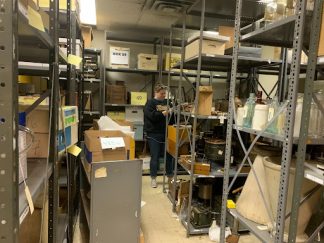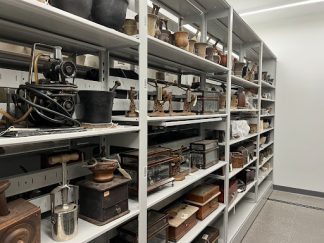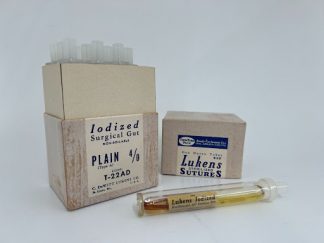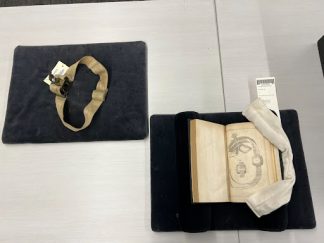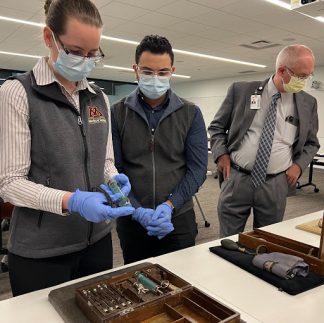By Abby Wright, intern
If you missed our previous installment, you can learn more about the Wangensteen Historical Library and the Legacy Grant here.
How does moving metadata from handwritten index cards to a spreadsheet to an online catalog revolutionize the Wangensteen Historical Library of Biology and Medicine’s medical artifact collection? Read on to find out!
The 2021 move
If you’ve ever had to move, you’ll know how much planning, effort and time it takes.
In 2021, the Wangensteen Historical Library of Biology and Medicine (WHL) moved from Diehl Hall to the Phillips-Wangensteen Building (PWB). The process had to be thorough to ensure the successful move of the WHL’s 8,400+ medical artifacts along with the 73,000+ rare books.
Moving the artifacts was particularly challenging. The WHL’s original home in Diehl Hall was not designed to accommodate artifacts, and they did not have catalog records. Luckily, the move presented an opportunity for a fresh start. Everything was inventoried, given a dedicated barcode, and now has its own place on a shelf or in a drawer in a beautiful, clean, well-lit and climate controlled space.
Before, you could only find information about the artifacts on handwritten index cards in small filing boxes. While this handwritten information was sparse and hard to search through, it was a good starting point for inventorying the artifacts.
Now, the next step is to take this fresh start to a whole new level in the form of publicly-accessible online catalog records for the artifacts.
An online collection
Medicine is an incredibly personal topic that deals with one of the most important aspects of the human condition– your health. As such, these records will conform to best practices for naming conventions, using guidance from resources provided by other institutions such as the National Library of Medicine’s Medical Subject Headings (MeSH) thesaurus.
In addition, the catalog is not a recommender system that works off of an algorithm, like Google, and instead is based on catalog records matching what someone searches. This means that a high level of specificity and accuracy is required when creating titles for artifacts. For example, an artifact’s title might be “Lukens sutures,” and the alternative titles would include “Sutures” and “Surgical Staples.”
One benefit of the catalog is that changes run off of an adaptable Python script that was created by kalan Knudson Davis, the Rare and Special Collections Metadata Librarian for the University Libraries. Data can be created about the artifacts, batch-loaded into the catalog, and changed when needed. By batch-loading data, large-scale changes can be made in a fraction of the time it would take by hand, allowing the WHL to make them available quickly.
Half of the catalog records will include images of the artifacts. Having these images serves as a substitute for seeing the artifacts in-person, and will serve as a guide for people to interact with and better understand them.
From Inanimate Artifacts to Living Pieces of History
Medical instruments have shaped approaches to disease and healthcare practice over time. The artifacts can help highlight shifting healthcare practices, experiences, and meanings.
The WHL uses these artifacts as teaching and research tools to help enrich students’ understanding of the historical world in which they were used. When studying artifacts alongside texts, students can engage with materials and make connections in new ways.
The majority of the WHL’s artifacts represent the practice and teaching of health and medicine in the upper Midwest and Minnesota. The collection includes objects related to cardiology, dentistry, pharmacy, surgery, nursing, public health, and more from the late nineteenth century until the mid-twentieth century.
Making these objects accessible and discoverable is the goal of this project. Through object research and metadata creation; reference photography; and digital 3D modeling via photogrammetry, our collection will launch online in 2024.
If you are interested in learning more about the 3D modeling process behind these artifacts, keep your eyes open for the next article in this three-part series!
 This project has been financed in part with funds provided by the State of Minnesota from the Arts and Cultural Heritage Fund through the Minnesota Historical Society.
This project has been financed in part with funds provided by the State of Minnesota from the Arts and Cultural Heritage Fund through the Minnesota Historical Society.
Abby Wright is a first-year student in the College of Liberal Arts (CLA), interning for the Spring 2023 semester at the Wangensteen Historical Library as part of the Dean’s First-Year Research and Creative Scholars program (DRAFCS).


